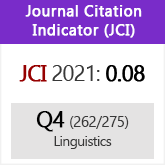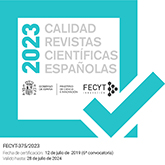Variation in the /kt/ sequence in Castilian Spanish: Synchronic study and diachronic applications
DOI:
https://doi.org/10.3989/loquens.2015.016Keywords:
synchrony-diachrony interface, sound change, Spanish, /kt/ sequenceAbstract
Diachronic phonetics and phonology in Spanish have not kept up to date with the latest methods in historical linguistics. Though acknowledging the value of traditional bibliography, this paper advocates an interdisciplinary, more modern approach. By way of example, an analysis is proposed of the evolution of /kt/ from Latin to Spanish. An experimental study of the sequence /kt/ in speakers from the Madrid area serves to argue that empirical synchronic data are an invaluable contribution that improve traditional views into diachrony. This paper seeks to invite reflection on possible ways of methodological renovation in the field of historical phonetics.
Downloads
References
Ariza Viguera, M. (1994). Sobre fonética histórica del español. Madrid: Arco/Libros.
Ariza Viguera, M. (1995). Manual de fonología histórica del español. Madrid: Síntesis.
Baldinger, K. (1972). La formación de los dominios linguüisticos en la Península Ibérica (versión española de E. Lledó & M. Macau; 2.ª ed.). Madrid: Gredos. (Obra original publicada en 1958)
Blevins, J. (2004). Evolutionary phonology: The emergence of sound patterns. Cambridge: Cambridge University Press. http://dx.doi.org/10.1017/CBO9780511486357
Blevins, J. (2006). A theoretical synopsis of Evolutionary Phonology. Theoretical Linguistics, 32(2), 117–166. http://dx.doi.org/10.1515/TL.2006.009
de Bustos Tovar, E. (1960). Estudios sobre asimilación y disimilación en el ibero románico. Madrid: Consejo Superior de Investigaciones Científicas.
Bybee, J. L. (2000). Lexicalization of sound change and alternating environments. En M. B. Broe & J. B. Pierrehumbert (Eds.), Papers in laboratory phonology V: Acquisition and the lexicon (pp. 250–268). Cambridge: Cambridge University Press.
Bybee, J. L. (2002). Word frequency and context of use in the lexical diffusion of phonetically conditioned sound change. Language Variation and Change, 14, 261–290. http://dx.doi.org/10.1017/S0954394502143018
Coseriu, E. (1981). Lecciones de lingu..stica general. Madrid: Gredos.
Delattre, P. (1965). Comparing the phonetic features of English, French, German and Spanish: An interim report. London: Harrap.
D'Introno, F., del Teso, E., & Weston, R. (1995). Fonética y fonología actual del español. Madrid: Cátedra.
Faginas, S. (2001). Análisis acústico de la sonoridad de /k/ en posición de coda silábica. En J. Díaz García (Ed.), Actas del II Congreso de Fonética Experimental. Sevilla, 5–7 de marzo de 2001 (pp. 167–172). Sevilla: Universidad de Sevilla.
Gil Fernández, J. (1988). Los sonidos del lenguaje. Madrid: Síntesis.
Hooper, J. B. (1976). An introduction to natural generative phonology. New York: Academic Press.
Jungemann, F. H. (1955). La teoría del sustrato y los dialectos hispano-romances y gascones. Madrid: Gredos.
Labov, W. (1994). Principles of linguistic change. Volume 1: Internal factors. Oxford: Blackwell.
Labov, W. (2001). Principles of linguistic change. Volume 2: Social factors. Oxford: Blackwell.
Lapesa, R. (1980). Historia de la lengua española. Madrid: Gredos.
Lloyd, P. M. (2003). Del latín al español. I. Fonología y morfología históricas de la lengua española (A. Álvarez Rodríguez, Trad.). Madrid: Gredos. (Obra original publicada en 1987)
Martínez Celdrán, E. (1984). Fonética. Barcelona: Teide.
Martínez Celdrán, E. (2013). Caracterización acústica de las aproximantes espirantes en español. Estudios de Fonética Experimental, 22, 11–35.
Martínez Celdrán, E., & Fernández Planas, A. M. (2013). Manual de fonética española. Articulaciones y sonidos del español (2.ª ed.). Barcelona: Ariel.
Menéndez Pidal, R. (1941). Manual de gramática histórica española (6.ª ed). Madrid: Espasa-Calpe.
Menéndez Pidal, R. (1950). Orígenes del español. Estado linguüistico de la Península Ibérica hasta el siglo XI. Madrid: Espasa-Calpe.
Meyer-Lu.bke, W. (1890). Grammaire des langues romanes. París: H. Welter.
Moya Corral, J. A., Bali-a, L., & Cobos, A. M. (2007). La nueva africada andaluza. En J. A. Moya Corral & M. Sosinski (Eds.), Actas de las XII Jornadas sobre la Ense-anza de la Lengua Española (pp. 275–284). Granada: Universidad de Granada.
Navarro Tomás, T. (1977). Manual de pronunciación española (19.ª ed). Madrid: Consejo Superior de Investigaciones Científicas. (Obra original publicada en 1918)
Ohala, J. J. (1971). The role of physiological and acoustic models in explaining the direction of sound change. Disponible en http://linguistics.berkeley.edu/~ohala/papers/role_of_physiological.pdf
Ohala, J. J. (1981). The listener as a source of sound change. En C. S. Masek, R. A. Hendrick, & M. F. Miller (Eds.), Papers from the parasession on language and behavior (pp. 178–203). Chicago: Chicago Linguistic Society.
Ohala, J. J. (1987). Explanations in phonology: Opinions and examples. En W. U. Dressler, H. C. Luschu.tzky, O. E. Pfeiffer, & J. R. Rennison (Eds.), Phonologica 1984. Proceedings of the Fifth International Phonology Meeting, Eisenstadt, 25–28 June 198 (pp. 215–225). New York: Cambridge University Press.
Ohala, J. J. (1989). Sound change is drawn from a pool of synchronic variation. En L. E. Breivik & E. H. Jahr (Eds.), Language change. Contributions to the study of its causes (pp. 173–198). Berlin: Mouton de Gruyter.
Ohala, J. J. (1993a). Sound change as nature's speech perception experiment. Speech Communication, 13, 155–161.
Ohala, J. J. (1993b). The phonetics of sound change. En C. Jones (Ed.), Historical linguistics: Problems and perspectives (pp. 237–278). London: Longman.
Ohala, J. J. (2005). Phonetic explanations for sound patterns: Implications for grammars of competence. En W. J. Hardcastle & J. M. Beck (Eds.), A figure of speech. A festschrift for John Laver (pp. 23–38). London: Erlbaum.
Ohala, J. J., & Kawasaki, H. (1984). Prosodic phonology and phonetics. Phonology Yearbook, 1, 113–127. http://dx.doi.org/10.1017/S0952675700000312
Ouakrim, O. (1994). Sobre la distinción entre la geminación y la tensión consonántica. Estudios de Fonética Experimental, 6, 153–169.
Penny, R. J. (2001). Gramática histórica del español (J. I. Pérez Pascual & M. E. Pérez Pascual, Trads.). Barcelona: Ariel. (Obra original publicada en 1991)
Pe-arroja Torrejón, L. (1990). El mozárabe de Valencia. Nuevas cuestiones de fonología mozárabe. Madrid: Gredos.
Rini, J. (1991). Metathesis of yod and the palatalization of Latin Medial /k'l/, /g'l/, /t'l/; /ks/, /ssj/; /kt/, /ult/ in Hispano- and Luso-Romance. En R. Harris Northall & T. D. Cravens (Eds.), Linguistic studies in Medieval Spanish (pp. 109–133). Madison: Hispanic Seminary of Medieval Studies, University of Wisconsin.
Rost Bagudanch, A. (2008). El proceso de yod segunda, ¿pasado o presente? En C. Company Company & J. G. Moreno de Alba (Eds.), Actas del VII Congreso Internacional de Historia de la Lengua Española. Mérida (Yucatán), 4–8 septiembre de 2006 (Vol. 1, pp. 311–326). Madrid: Arco/Libros.
Rost Bagudanch, A. (2009). La evolución de nj. Consideraciones diacrónicas en el marco de la fonología evolutiva. En J. Rafel Cufí (Ed.), Diachronic linguistics, (pp. 165–192). Girona: Documenta Universitaria.
Rost Bagudanch, A. (2011). Variación en los procesos de palatalización de yod segunda (o cómo la sincronía permite la explicación de la diacronía) (tesis doctoral). Girona: Universitat de Girona. Disponible en http://www.tdx.cat/handle/10803/31860.
Published
How to Cite
Issue
Section
License
Copyright (c) 2015 Consejo Superior de Investigaciones Científicas (CSIC)

This work is licensed under a Creative Commons Attribution 4.0 International License.
© CSIC. Manuscripts published in both the printed and online versions of this Journal are the property of Consejo Superior de Investigaciones Científicas, and quoting this source is a requirement for any partial or full reproduction.All contents of this electronic edition, except where otherwise noted, are distributed under a “Creative Commons Attribution 4.0 International” (CC BY 4.0) License. You may read here the basic information and the legal text of the license. The indication of the CC BY 4.0 License must be expressly stated in this way when necessary.
Self-archiving in repositories, personal webpages or similar, of any version other than the published by the Editor, is not allowed.















